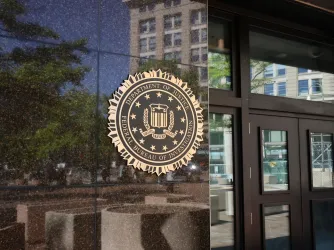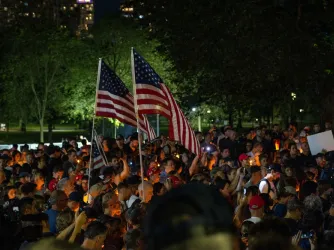Table of Contents
When Schools Punish Creative Work
As Samantha points out this morning, today's Wall Street Journal features an excellent article by Elizabeth Bernstein on schools that punish students for their creative work—sometimes with good intentions, when there is a real chance that the work signifies that someone is dangerous—and sometimes vindictively, such as in the case of student T. Hayden Barnes at Valdosta State University. Barnes, an environmentalist who was protesting against new parking garages, was expelled after he published an innocent collage (see for yourself) on Facebook.com that Valdosta's president disingenuously chose to interpret as a threat to his life.
The WSJ piece explains that even when schools are trying to do the right thing, they are likely to trample on student rights:
[S]ome experts worry that these measures pose legal or ethical risks. Psychologists caution that it is nearly impossible to predict future violence. Professors are being asked to do something for which they are untrained—assess a work for signs of a troubled psyche. Complicating the issue further, college students are at an age where the part of the brain that manages behavior is still developing, so they don't always understand the consequences of their words. "It takes a lot more than one or two papers to see if someone has a psychiatric problem," says Gwen Dungy, executive director of NASPA—Student Affairs Administrators in Higher Education. [link added]
If they overreact, schools could violate students' privacy and civil rights.
All too often, this is the case. Time and again, schools vindictively claim that expression constitutes a "threat" in order to punish students' (and even faculty members') creative expression. Take, for instance, the ongoing case at Colorado College, where two students were punished for posting a parody flyer (see for yourself) around campus. The students were making fun of various aspects of a feminist newsletter called "The Monthly Rag" with their own poster, "The Monthly Bag." The poster clearly was a nonviolent parody—actually a double parody, because they were also making fun of stereotypical guy stuff—chainsaws, details about sniper rifles, how to engage in a certain sexual position—in the context of a quotation from Theodore Roosevelt and a serious question about the existence of a "glass ceiling" in certain areas. But having offended feminists on campus, the student parodists were soon subjected to a three-hour trial and then found guilty of "violence." Their crime? The "juxtaposition of weaponry and sexuality." Colorado College's president, Richard Celeste, at first had excoriated the students for their "demeaning" language, but once it became clear that the innocent students had been punished simply for their creative expression, Celeste began to hang his entire case on the reference to sniper rifles in the parody.
To this day, Celeste has refused to budge, even though Vice President Mike Edmonds found that the students had never actually threatened anyone. Instead, Celeste and Edmonds have accepted the unsupportable principle that when someone feels offended and can make a claim of feeling threatened, this is enough to punish. (See Greg Lukianoff's Huffington Post piece, "What Can The Virginia Tech Tragedy Do For Me?") For its unrepentant punishment of student expression, Colorado College has been added to FIRE's Red Alert list.
Sadly, Colorado College is not the only school where creative expression has been punished in recent years, whether it has been for alleged violence or something else. In March, Arksansas Tech cancelled a student production of Stephen Sondheim's Assassins because the show included guns (no matter that they were wooden and obviously fake). And Yale attempted something similar after the Virginia Tech shootings, banning realistic-looking weapons from theatrical productions at the school (before backing down somewhat under public pressure).
Yale also has been in the news recently after banning a highly controversial piece of student art on the basis of a variety of reasons (some better than others) including a statement from none other than the dean of Yale's School of Art: "This is not an acceptable project in a community where the consequences go beyond the individual who initiates the project..." But if this were really the standard, only the most solipsistic art would be safe from censorship and punishment.
At Washington State University in 2005, the school actually financed and organized the disruption of a play called Passion of the Musical (a parody of the movie The Passion of the Christ) by a student playwright.
At Tufts University last year, a student publication called The Primary Source was punished for "harassment" after printing a parody (see for yourself) of a Christmas carol under the title, "O Come All Ye Black Folk."
At the Art Institute of California in San Francisco, according to ABC 7 News in San Francisco, a student who majored in "game art" wrote a story about black kids on a killing rampage, complete with AK-47s, in order to expose the racism he saw in some video games. After his professor printed 500 copies to distribute around campus, the work was censored and the professor was fired.
As this example shows, even professors are not safe when it comes to artistic expression. At the University of Alaska at Anchorage in 2001, a professor who was a poet and teacher of creative writing was subjected to administrative interference and investigation because of the content of her work. After she published a poem, "Indian Girls," about the sexual abuse of children, some Native Alaskan students in her class protested and various officials at the school began to circulate emails about "referring" the case to deans, "resolving" the matter, and "reporting back" on university findings.
The good news in the Alaska case is that the president of the University of Alaska, Mark R. Hamilton, came to the rescue of the professor with a ringing endorsement of free expression:
What I want to make clear and unambiguous is that responses to complaints or demands for action regarding constitutionally guaranteed freedoms of speech CANNOT BE QUALIFIED. Attempts to assuage anger or to demonstrate concern by qualifying our support for free speech serve to cloud what must be a clear message. Noting that, for example, "The University supports the right to free speech, but we intend to check into this matter," or "The University supports the right of free speech, but I have asked Dean X or Provost Y to investigate the circumstances," is unacceptable. There is nothing to "check into," nothing "to investigate."
Opinions expressed by our employees, students, faculty or administrators don't have to be politic or polite. However personally offended we might be, however unfair the association of the University to the opinion might be, I insist that we remain a certain trumpet on this most precious of Constitutional rights.
Such a clear embrace of freedom of expression is all too rare on today's college campuses. Where is President Celeste of Colorado College? Where is President Lawrence Bacow of Tufts? Where is President Ronald Zaccari of Valdosta State (other than taking an early retirement)? University presidents should be following Mark Hamilton's example of protecting rather than punishing the creative work of students and professors.
Recent Articles
Get the latest free speech news and analysis from FIRE.

VICTORY: Court vindicates professor investigated for parodying university’s ‘land acknowledgment’ on syllabus

Can the government ban controversial public holiday displays?

DOJ plan to target ‘domestic terrorists’ risks chilling speech
